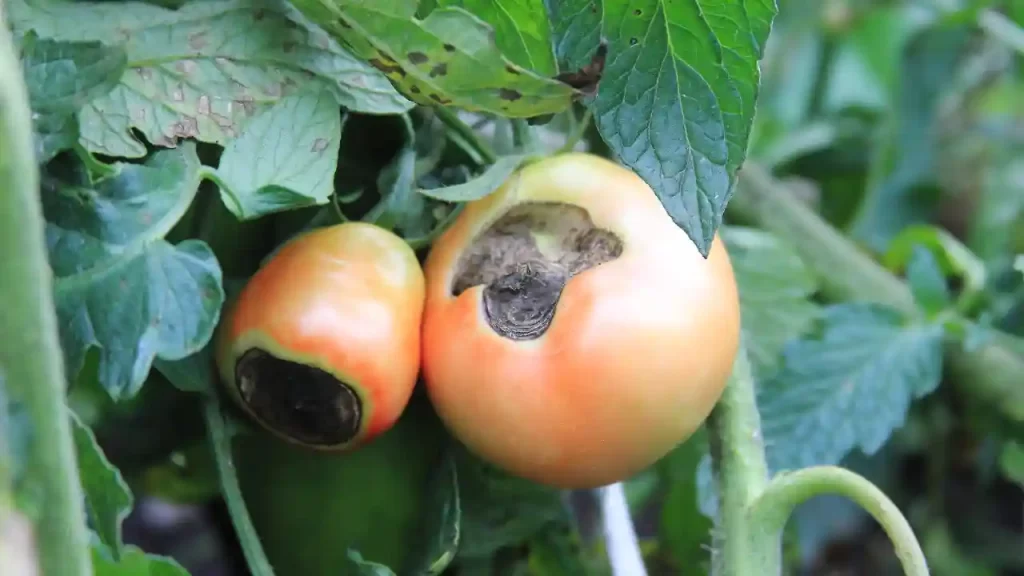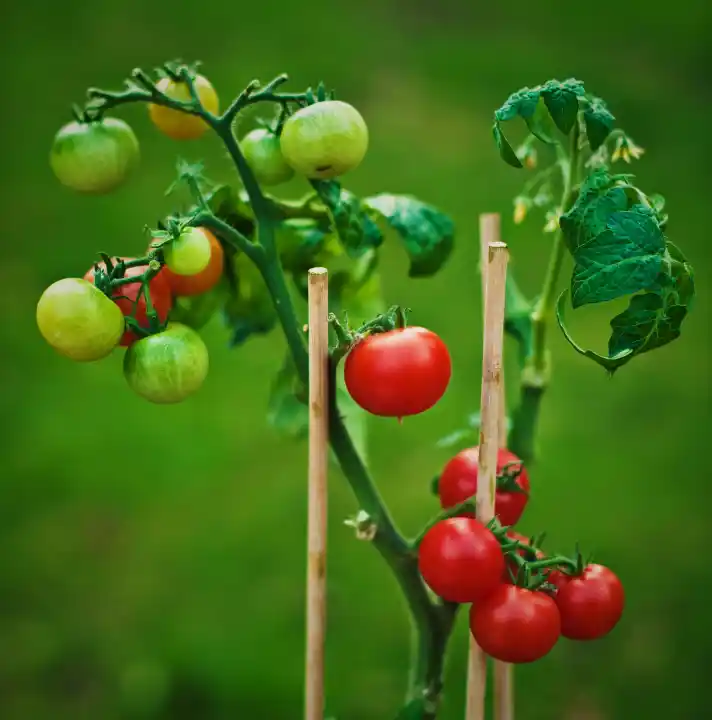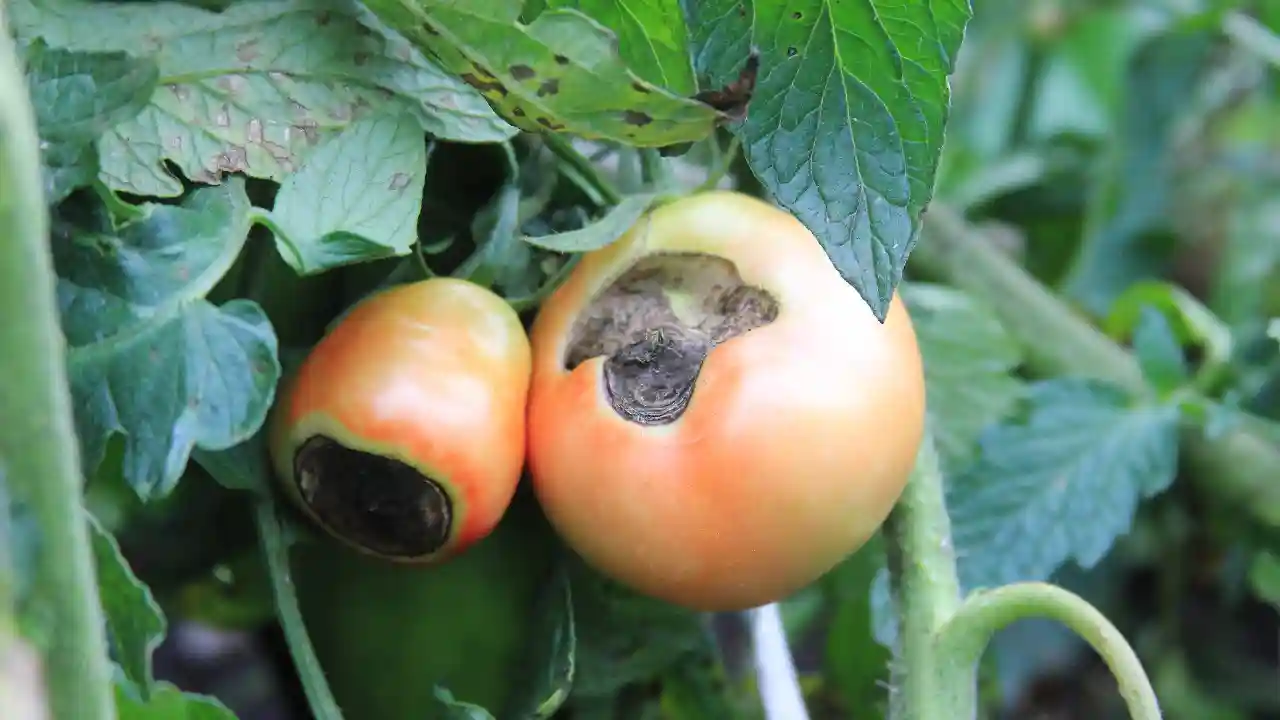If you plant tomatoes in bad quality with high nitrogen contained soil, it can lead to tomatoes rotting. As a result, roots become inefficient in supplying adequate nutrients and water to the plant. The most common reason for tomatoes rotting is overwatering, which worsens if its soil has a bad drainage system.
Sometimes people use harsh techniques to increase the production of tomatoes, which deteriorates the soil quality, and loses soil nutrients faster.
4 Reasons Why Tomatoes Rot on the Vine

I have found 4 reasons for tomatoes to rot, and if you take proper measures, you can save tomatoes from rotting.
Let’s discuss the common reasons for tomatoes rot.
Too Much Moisture in the Soil
Moisture in the soil is needed only up to a certain extent for proper growth and the long life of tomato plants.
But if the soil remains overly moist, it becomes one of the biggest reasons for tomatoes to rot. It happens when tomatoes are overwatered and have to face a rainy season.
Soil is not able to absorb moisture due to a lack of sunlight, and a bad drainage system results in tomato root decomposition.
You should take the following measures to prevent your tomatoes from rotting:
- Ensure a good drainage system of the soil.
- Check the level of moisture in the soil by sticking your finger. If the soil is dry up to 5 Cm, it is the right time to water your tomato plants.
- Try to plant your tomatoes with good exposure to sunlight.
- Reduce the frequency of watering your tomato plants during rainy weather.
Poor Soil Quality

We often plant our tomatoes without knowing the soil quality and cultivate them in poor-quality soil, making them rot.
The soil, which does not have good nutritional value and lacks calcium, would destroy the life of your tomato plants, and rot happens.
On the other hand, high doses of nitrogen fertilizers promote tomato rotting as the roots cannot deliver calcium to the plant and blossom end rot occurs.
The following measures should be taken to prevent blossom end rot:
- Soil rich in phosphorus and low contained in nitrogen should have opted for tomato plant cultivation.
- Use the fertilizer with 2 parts of phosphorus and 1 part of nitrogen for healthy tomatoes.
- The right amount of nitrogen use helps the roots deliver adequate calcium for the plants, protecting them from rotting.
Aggressive Weeding
Aggressively weeding in your tomato plants can worsen the condition of your tomato plants, and rotting happens. In addition, due to this process, the roots of the plants are negatively impacted as they have a very critical root system.
When roots weaken, they become inefficient enough to deliver nutrients and water to the plant, and the plant dies.
You should do 3 – 4 inches of mulching to overcome this issue, which also helps maintain the right amount of moisture in the soil.
Rapid Growth

Sometimes, in the greed of the rapid growth of tomatoes, harsh and too much fertilizer is used, which rapidly reduces the nutrients and calcium of soil and results in the rot of tomatoes in vines.
Due to a lack of calcium in the soil, plants cannot produce fruits, and even bad-quality rotten tomatoes are formed in your plants.
So you should always wait for your tomatoes to grow on their own. Keep good exposure to sunlight, water them properly, and your good tomatoes grow quickly.
What is The Most Common Type of Tomato Rot?
The most common tomato rot noticed in tomato plants is blossom end rot. You can see some spots in the bottom of the tomato, and slowly the spots spread to the whole fruit and taste mushy, watering and rotten.
It is almost impossible to overcome tomato rot. So you should take proper measures to avoid such conditions.
If you are curious to find out and prevent tomato diseases, check our article on Treatment for Powdery Mildew on Plants.
How To Prevent Tomatoes From Rotting On The Vine?

You can use the techniques I use to prevent rotting and easily save your ripe tomatoes from rotting.
- Using good quality soil with less nitrogen and phosphorus promotes a healthy life for tomatoes.
- An accurate and consistent soil moisture level, a good drainage system, and proper watering promote the life of tomatoes.
- Good exposure to sunlight is an important factor for your tomato plants.
- Using Fertilizer with 2 parts of phosphorus and 1 part of nitrogen prevents the tomatoes from rotting. Less use of nitrogen fertilizer is healthy for the plant.
- The use of mulch prevents the weeding of tomato plants, and keeping the soil moist is an added advantage.
- You should use fertilizers before the growth of green tomatoes.
- Ensure using fertilizers once in 2 weeks only.
If you opt for the above measures, your tomato plants will grow rapidly and produce quality tomatoes.
Why Are My Tomatoes Rotting on The Vine?
If your tomatoes are not getting favourable conditions, it starts rotting on the VineVine. The reasons are listed below:
- Overwatering the tomatoes is a common factor in rotting and causes bottom-end rot.
- The use of excessive fertilizers that are rich in nitrogen rots the tomato plants.
- Cultivated in bad quality soil lacking nutrients, plants cannot get sufficient calcium supply, and rotting happens.
- Aggressive weeding leads to rotting in tomato roots as they are delicate and harmed.
- Forcing rapid growth of tomatoes with excessive use of fertilizers. Due to this, soil loses its nutrients rapidly and results in rotten tomatoes.
Why are my tomatoes mushy on the vine?
It is probably caused by nitrogen being overly high and potassium a bit below zero. Nitrogen must have an average concentration of 45% to 5.7% in leaf tissues.
As per research of Mississippi State University, tomatoes becomes mushy on the vine due to high nitrogen and low potassium in tomato plant. The average amount of required nitrogen that a plant requires is 4% to 5.5% in leaf tissue.
High nitrogen is tomato also leads to curling in leaves, missed flower clusters and balling up of the plant’s top.
Can overwatering cause blossom end rot?
According to the research done by Iowa State University, Blossom Rot occurs when the developing fruit have calcium deficiency.
Some of the reasons that can lead to blosson end rot are fluctuation in soil moisture due to overwatering or drought, use of high nitrogen fertilizer, and root pruning during cultivation.
Summary
When growing tomatoes, you should try your best to protect the rotting in tomatoes by watering them properly, cultivating them in good soil and maintaining correct moisture levels in the soil. Your plants become efficient in producing quality tomatoes.
